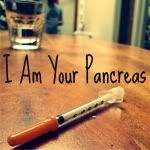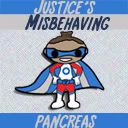Saturday, December 12, 2009
Glossary of Terms
10:41 PM
I am plagiarizing from Joanne’s blog in hopes that my family and friends will have a better understanding of the things I discuss here on my blog. Thanks, Joanne!
Glossary of Terms
.
#g of carbs this is not a weight, but the amount of carbs that can be found in the food Nate eats. For
A1C A blood test that is used primarily to monitor the glucose control of diabetics over time.
BG Blood Glucose. Refers to the amount of sugar in Nate’s blood. His optimal level is 100 - 200.
Celiac Disease (CD) a digestive condition triggered by consumption of the protein gluten (found in bread, pasta, cookies, pizza crust and many
other foods containing wheat, barley or rye). If you have CD and eat foods containing gluten, an immune reaction occurs in your small intestine, causing
damage to the surface of your small intestine and an inability to absorb certain nutrients. The decreased absorption of nutrients that occurs with CD can cause vitamin deficiencies that deprive your brain, peripheral nervous system, bones, liver and other organs of vital nourishment. This can lead to other illnesses and stunted growth in children. No treatment can cure celiac disease. However, you can effectively manage celiac disease through
changing your diet. It is thought that approximately 10% of children with Type 1 Diabetes also have Celiac's Disease.
Certified Diabetes Educator (CDE) multidisciplinary health professionals (usually an RN) who teach people with diabetes.
When Nate was diagnosed, a CDE met with us each day in the hospital to teach us how to care for him.
D Instead of typing out diabetes, I'll just use the letter D.
Diabulimia an eating disorder in which people with Type 1 Diabetes deliberately give themselves less insulin than they need, for the purpose of weight loss. Failure to administer insulin places the body in a starvation state, resulting in breakdown of muscle and fat into ketones, while at the same time making the body unable to process sugars that have been consumed, so the sugars are excreted rather than being used by the body for energy or stored as fat.
DKA A life threatening condition that develops when cells in the body are unable to get the sugar they need for energy. Symptoms include: flushed, hot, dry skin, blurred vision, feeling thirsty, drowsiness or difficulty waking up, rapid, deep breathing, strong, fruity breath odor, loss of appetite, abdominal pain, vomiting, and confusion. Severe DKA leads to difficulty breathing, swelling of the brain, and there is a risk of coma and even death.
Dx Diagnosis
Endo short for Endocrinologist, the specialist Nate sees for his diabetes.
Glucagon (kit) Glucagon is used to treat insulin coma or insulin reaction resulting from severe hypoglycemia (low blood sugar). Glucagon is used in
emergency situations when the patient is unconscious. Within the glucagon kit is a vial of powdered glucagon and a syringe filled with liquid (diluent). The dose is prepared immediately before injection.
High A BG over 200
Humalog One of the two insulins Nate is on. It is Rapid acting insulin that he takes before breakfast and dinner. I refer to it as H.
Humulin (NPH) The other insulin that Nate is on. It is an intermediate acting insulin with a slower onset of action and a longer duration of activity.
Sometimes I refer to it as N or NPH.
Ketones They are produced when there is not enough insulin to help Nate's body use sugar for energy. Without enough insulin, glucose builds up in
the blood. Since the body is unable to use glucose for energy, it breaks down fat instead. When this occurs, ketones form in the blood and spill into the urine. These ketones can make him very sick. Healthy people can also spill ketones when they are ill. Nate gets tested for ketones if his BG is over 250 or he's sick.
Ketostix - Urine-testing strips, also called ketone sticks are small plastic strips that have a little absorptive pad on the end. This contains a special chemical that will change color in the presence of ketones in the urine. The strips may change varying shades of pink to purple, or may not change color at all, depending on the amount of ketones (dark purple = bad, beige = yay!). The container has a scale on the label, with blocks of color to compare the strip after a certain time lapse, usually 15 seconds.
Low - A BG under 80
MDI - Multiple Daily Injections. This is how we give Nate his insulin.
Pedi - Pediatrician.
Type 1 Diabetes - Once known as juvenile diabetes or insulin-dependent diabetes, it is a chronic condition in which the pancreas produces little or no insulin, a hormone needed to convert sugar (glucose) into energy. Although type 1 diabetes can develop at any age, it typically appears during childhood or adolescence. Various factors may contribute to type 1 diabetes, including genetics and exposure to certain viruses. Despite active research, type 1 diabetes has no cure.
Type 2 Diabetes - Often called non-insulin dependent diabetes; it is the most common form of diabetes, affecting 90% - 95% of the 21 million people with diabetes. Unlike people with type 1, people with type 2 diabetes produce insulin; however, the insulin their pancreas secretes is either not enough or the body is unable to recognize the insulin and use it properly. Those at highest risk for the disease are those who are obese or overweight, women who have had gestational diabetes, and people with family members who have type 2 diabetes.
Low - A BG under 80
MDI - Multiple Daily Injections. This is how we give Nate his insulin.
Pedi - Pediatrician.
Type 1 Diabetes - Once known as juvenile diabetes or insulin-dependent diabetes, it is a chronic condition in which the pancreas produces little or no insulin, a hormone needed to convert sugar (glucose) into energy. Although type 1 diabetes can develop at any age, it typically appears during childhood or adolescence. Various factors may contribute to type 1 diabetes, including genetics and exposure to certain viruses. Despite active research, type 1 diabetes has no cure.
Type 2 Diabetes - Often called non-insulin dependent diabetes; it is the most common form of diabetes, affecting 90% - 95% of the 21 million people with diabetes. Unlike people with type 1, people with type 2 diabetes produce insulin; however, the insulin their pancreas secretes is either not enough or the body is unable to recognize the insulin and use it properly. Those at highest risk for the disease are those who are obese or overweight, women who have had gestational diabetes, and people with family members who have type 2 diabetes.
Subscribe to:
Post Comments
(Atom)

Just a Mom
I am NOT a doctor, nor do I play one on this blog.
I AM a wife.
I AM the mom of 3 wonderful children.
I AM my son's pancreas.
The information provided on this blog is from our personal experiences with Type 1 diabetes. Because something works for us does not mean it will work for you.
Please consult your doctor if you have any questions or concerns about your health care options.
I AM a wife.
I AM the mom of 3 wonderful children.
I AM my son's pancreas.
The information provided on this blog is from our personal experiences with Type 1 diabetes. Because something works for us does not mean it will work for you.
Please consult your doctor if you have any questions or concerns about your health care options.
Powered by Blogger.
Grab my button!




Check out these AWESOME
D-rent Blogs . . .
D-rent Blogs . . .
Followers

My Blog List
-
-
-
-
Winter Solstice1 year ago
-
-
-
Post-Pod Supper5 years ago
-
-
-
-
Coexisting with dark places.6 years ago
-
Pod Hockey6 years ago
-
-
-
The Mirror7 years ago
-
Jon Obst - RIP7 years ago
-
-
Stars Aligned….8 years ago
-
For the Newly Diagnosed...8 years ago
-
Happy Easter 20169 years ago
-
-
-
Hope10 years ago
-
10 Years Ago Today10 years ago
-
UPDATES UPDATES UPDATES10 years ago
-
Lucas-isms10 years ago
-
-
-
Diabetes Resolutions10 years ago
-
T-Slim - I'm beginning to love you...11 years ago
-
-
Worry...Worry...WORRY!11 years ago
-
I NEED The Arrows!!11 years ago
-
Anyone have ink?11 years ago
-
-
-
Goodbye Sweet Friend12 years ago
-
For You, My Friend12 years ago
-
-
For Shamae12 years ago
-
Karen Jensen, RD12 years ago
-
Callan12 years ago
-
-
3 Years12 years ago
-
Email Subscriptions.12 years ago
-
Growing up and letting go12 years ago
-
Bye Bye Insulet, Hello Medtronic12 years ago
-
-
Hope on 2 Wheels Documentary12 years ago
-
-
Cross Talk Radio Show Link :)13 years ago
-
Back to School - Our Lunch Time Dilemma13 years ago
-
-
How To Manage Your Stockpile13 years ago
-
Russian Custard13 years ago
-
Diabetes Tourettes13 years ago
-
A story13 years ago
-
10 years13 years ago
-
Were Off to see the Wizard13 years ago
-
I’m Just Not That Into This.13 years ago
-
CBS 5... Shame On You!14 years ago
-
JDRF Walk to Cure Diabetes14 years ago
-
totally random14 years ago
-
I think I can breath again14 years ago
-
-
Weekend Meme14 years ago
-
Think positive...14 years ago
-
Lipoatrophy14 years ago
-
-
-
"What I Am"14 years ago
-
-
Missing.....14 years ago
-
I'm BACK!15 years ago
-
-
SleepOVERS!!!15 years ago
-
-
-
-
-
-
-
-
-
-
-
-
-
-
-
-
-
-
































2 comments:
wow Laura kuddos to you for doing this so maybe some ppl can understand what we go through everyday . thanks again for sharing and posting this . God bless and hugs to you and yours .
Great Posting. Thanks For your post!!